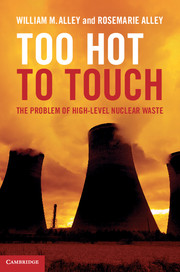Book contents
- Frontmatter
- Contents
- Acknowledgments
- List of units
- List of abbreviations
- Introduction
- Part I The problem
- 1 The awakening
- 2 Brainstorming
- 3 The ocean as a dumping ground
- 4 Radioactivity and atomic energy
- 5 The Cold War legacy
- 6 The peaceful atom and its wastes
- 7 Recycling
- 8 Dry cask storage
- 9 Interim storage
- 10 A can of worms
- 11 WIPP
- Part II The mountain
- Part III No solution in sight
- Appendix Discussion questions
- References
- Index
7 - Recycling
from Part I - The problem
Published online by Cambridge University Press: 05 February 2013
- Frontmatter
- Contents
- Acknowledgments
- List of units
- List of abbreviations
- Introduction
- Part I The problem
- 1 The awakening
- 2 Brainstorming
- 3 The ocean as a dumping ground
- 4 Radioactivity and atomic energy
- 5 The Cold War legacy
- 6 The peaceful atom and its wastes
- 7 Recycling
- 8 Dry cask storage
- 9 Interim storage
- 10 A can of worms
- 11 WIPP
- Part II The mountain
- Part III No solution in sight
- Appendix Discussion questions
- References
- Index
Summary
Perpetual care is neither difficult nor costly, chiefly because the inherent volume of nuclear waste is small.
Chauncey Starr and R.P. Hammond (1972)Recycling as a means to reduce waste and conserve resources is viewed as good for the environment. In a society that routinely recycles aluminum cans, plastic containers and cardboard, the idea of recycling nuclear waste seems self-evident. So why aren't we doing it?
In the nuclear world, recycling refers to reuse of nuclear spent fuel after its recovery through reprocessing, although the two terms recycling and reprocessing tend to be used interchangeably. Reprocessing was well developed by the atomic weapons program long before commercial reactors went on-line. The world’s first industrial-scale reprocessing plant began operation at Hanford in December 1944. The plant produced the plutonium that went into the bombs exploded at the Trinity test site in New Mexico and dropped on Nagasaki, Japan.
In the early days, it was taken for granted that reprocessing would be incorporated into the commercial application of nuclear energy. Advocates of reprocessing pointed out that it would close the nuclear fuel cycle. Since spent fuel contains 95 percent of the original uranium plus some plutonium, conceivably there is lots of potential nuclear energy remaining that would be “thrown away” in the once-through cycle. The only problem is that reprocessing of spent nuclear fuel turned out to be a technologically complex, expensive, accident-prone, and very messy business – and only marginally addressed the waste problem.
- Type
- Chapter
- Information
- Too Hot to TouchThe Problem of High-Level Nuclear Waste, pp. 93 - 111Publisher: Cambridge University PressPrint publication year: 2012



